|
MEETING # 1631
4:00 P.M.
March 2, 2000
An American Aristocracy
The Livingstons
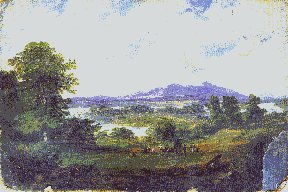
by Robert Eaton Morse
Summary
The Indians called it "The River That Flows Two Ways", because it is tidal
for the first hundred and fifty miles – all the way from New York up to Albany. Henry
Hudson, who sailed it in 1609 looking for a northwest passage to the Orient, christened it
the Mauritius, after the Dutch under whom he served. Ruler and sailor were both
disappointed: there was no northwest passage. Even so, by the end of the seventeenth
century, the river that bore Hudson’s name had become America’s busiest
commercial and military thoroughfare – and Robert Livingston, the young Scotsman who
had managed to possess himself of much of it’s central valley, was well on his way to
establishing the second of the great colonial American aristocracies. Virginia’s
first families had landed first, by just a few years.
Biography of the
Author
 The author, Robert Eaton
Morse was born in Franklin, New Jersey in 1920. He attended Williams College and graduated
from the University of Virginia. During World War ll he served in the Army Air Corps from
1942 – 1946. His Masters degree was earned at New York University with subsequent
Doctoral work at Ohio State, Wayne State, and the University of California. He was in
private industry in various financial management capacities, later rejoined the U.S. Air
Force and served in a civilian capacity at a number of locations throughout the United
States. He is retired and involved in a number of community activities. The author, Robert Eaton
Morse was born in Franklin, New Jersey in 1920. He attended Williams College and graduated
from the University of Virginia. During World War ll he served in the Army Air Corps from
1942 – 1946. His Masters degree was earned at New York University with subsequent
Doctoral work at Ohio State, Wayne State, and the University of California. He was in
private industry in various financial management capacities, later rejoined the U.S. Air
Force and served in a civilian capacity at a number of locations throughout the United
States. He is retired and involved in a number of community activities.
An American Aristocracy – The Livingstons
1674 – 1700 Robert
In April 1673, at the age of eighteen, Robert Livingston sailed from Scotland for the
New World. He landed first in Charles town, Massachusetts in December 1673 and presented
himself to the prominent Winthrop family, his father, a Scottish clergyman's, connection
in the Bay Colony. He became acquainted with John Hull, a respected silversmith and fur
trader who was seeking new sources of beaver pelts for export to Europe. Because of
Livingston’s fluency in the Dutch language, acquired in his early years of residence
in Rotterdam Holland, he was considered by Hull to be an excellent candidate to serve as
Albany’s agent.
The fur trade in Western New England had so depleted the supply of beaver that
expansion further to the West was critical. Even though the English had seized New York
from the Dutch in 1664, they were unable to govern without the cooperation of the
entrenched Dutch merchants of the town of Albany, a small trading post situated 150 miles
upriver from Manhattan on the edge of the western wilderness.
The forests on the western frontier, across the Hudson River in the province of New
York, were also rich in beaver; but the supply of pelts there was under the control of the
mighty Five Nations of the Iroquois, who traded exclusively with the Dutch Merchants. In
trade, society, and day to day governance, the life of Albany was dominated by a small,
closed, jealous Dutch establishment, whose suspicions of everything English extended to
the inhabitants of the New England colonies – all of which had so far discouraged
John Hull from attempting to infiltrate the ranks of Albany trade.
It was therefor most expedient to Hull and the other Boston traders to have in their
employ a person who could deal one on one with the Dutch. Livingston was their man. During
his first few months in Albany, Livingston had taken pains to ingratiate himself with the
town’s most prominent personage, Nicholas Van Rensselaer, director of Rensselaerwyck,
the greatest of the Dutch patroonships.
The patroonships (which were called manors after the English takeover in 1664) were
mammoth land grants given on very easy terms by both the Dutch and English provincial
governments in order to promote quick settlement of New York’s vast territory. The
patroon or lord received his enormous parcel of land in exchange for a pledge to import
and establish a certain number of settlers within a fixed period of time. He also paid an
annual quitrent to the Crown, and in turn collected rents from the settlers who cleared
the land and planted crops. Tenant farmers signed on for life, might pay a larger quitrent
than their lord’s annual fee for his entire fiefdom, yet no tenant was permitted to
buy his farm. Title remained perpetually with the lord.
Renselaerwyck, which had been granted to Nicholas’ father by the Dutch West India
Co. in the 1630s, comprised upward of 700,000 acres on both sides of the Hudson, with the
town of Albany at its center. Nicholas, shortly after arriving in Albany in October 1674,
had been appointed as the director and 3 months later married the reigning belle of Albany
society, 18 year old Alida Schuyler, in what was very likely an arranged marriage between
the two early arrival families of prominence, Schuylers and Van Rensselaers.
The newly married couple moved into the patroon's house and in the house next door
lived Robert Livingston, a lively, able young man, eager for employment, ingratiating and
experienced in business.
Nicholas having neither the patience nor the inclination to administer his huge
holdings set about looking for an able secretary. And so Livingston became secretary to
Rensselaerwyck. Shortly after becoming the secretary he was appointed secretary to the
town of Albany and a few months later, secretary to the newly formed, extremely sensitive
Board of Indian Commissioners. Robert now had fingers in all the choicest pies:
Rensselaerwyck, the town of Albany, the colonial government and the Iroquois Council.
Singly, any one of the offices was a source of influence and prestige, together they could
exert enormous political leverage; on paper at least, he was sitting pretty.
The trouble was that all three of his employers had a bad habit of not paying their
salaries on time, if at all. So despite his income from the fur trade he was soon in debt,
but kept all of his creditors at bay until an event that transformed Robert in
everyone’s eyes; he married the recently widowed Alida Schuyler Van Rensselaer.
Alida had shared a childless marriage with Nicholas, some 20 years her senior, for
almost four years. In November of 1678 her husband was suddenly taken gravely ill and
shortly thereafter expired. Robert carried Alida off to the altar within the following
eight months.
Soon thereafter Livingston embarked on a petition of acquisition of 2000 acres on the
East Side of the Hudson River south of Albany, directly across from the high peaks of the
Catskill Mountains. The final patent was issued four years later on November 4, 1684. One
year later, in 1685, he filed a petition to purchase an additional 300 acres to the east
of his riverfront property," in the territory called by the Indians Tachkanick"
– 300 acres that mysteriously doubled into " about 600" by the time the
patent was officially recorded a few months later. July 22, 1686 is the official date on
which Robert Livingston, a thirty–one year old immigrant merchant, son of a humble
Scottish clergyman, was by royal patent transmogrified into " Robert Livingston, Lord
of Livingston Manor". A patent which describes his two parcels of land as "
adjacent". The 2000 acres along the river and the 600 acres far inland had, as it
were, gobbled up the 157,000 acres in between making him owner of 160,000 acres of the
East bank of the Hudson River and master of a potential manorial manage straight out of
the Middle Ages. A dash of the gubernatorial pen added 250 square miles to Robert’s
possessions all in exchange for 28 shillings annual quitrent to the Crown of England.
The wording of Robert’s royal patent was identical to the standard, centuries old
English baronial grant, complete with vassals and quitrents, days riding, courts leet and
baron, and the right to appoint clergy. Had he arrived in New York a few years earlier,
when it was still New Netherlands and owned by the Dutch, his title would have been
Patroon instead of Manor Lord. Patroon or Lord, the title sounded much grander than it
was. Livingston Manor in 1686 was nothing more than a vast wilderness, untenanted,
unimproved and unprofitable. It took Robert some forty years to remedy that, and in the
meantime he matter-of-factly styled himself " Robert Livingston, Merchant".
Meanwhile the manor sat, waiting. The primary stumbling block was the tenant system
itself – a system whereby no tenant farmer, however industrious and ambitious,
however faithful in payment of rent, " fat hens" and days riding to his
landlord, could ever receive title to his farm. Naturally, the most enterprising and able
immigrant – men whose desire for independence and proprietorship ran just as deep as
Robert Livingston’s – chose instead to settle in the neighboring colonies of
Massachusetts and Connecticut, where sizable freeholds were plentiful.
New York manor lords had to settle for newcomers with no capital and no prospects.
Desperate to people their fiefdoms, the manor proprietors often ransomed whole families
out of indentured servitude and then offered them attractive lease terms: an initial
rent-free period of a year or more, free provisions for the first year, and seed gifts of
livestock and fruit trees. To the down and out, the tenant system offered a chance of
getting started, for which many were willing to sacrifice their independence.
From the proprietors’ point of view, settlement was agonizingly slow; during its
first three decades of existence Livingston Manor attracted only about thirty tenant
families. At that rate it takes a long time to turn 160,000 acres to profit, and meanwhile
the lord and lady of the manor lived in town and worked, just like everybody else. To a
large degree, Robert and Alida lived on credit and their wits, borrowing here, lending
there, and never letting their creditors compare notes.
Robert was extremely proficient at these elaborate financial balancing acts. He always
seemed to live well – and he was always short of cash. Like all provident parents,
they planned each son’s future with one eye toward his individual advancement and the
other on his usefulness to the family. The family’s role as an economic unit was
extremely important, every member was trained to make his contribution to the whole.
1700 – 49 First Generation: Philip and Robert
Robert and Alida had a total of ten children, six of whom survived to maturity, four
sons:
John, Philip, Robert, and Gilbert, and two daughters, Margaret and Joanna. John, the
oldest, was destined to become the second proprietor of Livingston Manor. However, since
the manor’s productive potential would be realized only in the distant future, John
was sent out in his teens to live with the Iroquois and learn the fur trade. Philip
embarked on a business apprenticeship with his Uncle Schuyler in Albany and Robert at age
12 had sailed for Edinburgh in 1698 to live with his Aunt Barbara and attend Latin School
in preparation for a career in law. As a younger son who would inherit neither the family
estates nor the family business, Robert required more elegant schooling then either of his
older brothers, John and Philip. Gilbert, at ten, was hardly old enough to bustle in the
world; still his character already seemed more to resemble that of his oldest brother,
John. Handsome and indolent, Gilbert had so far failed to distinguish himself at his
studies or to exhibit any enthusiasm for the profession his parents had chosen for him at
birth, the ministry.
In 1715, Robert (Lord of the Manor) was given the opportunity to obtain a royal
confirmatory patent from the British Crown for the Manor of Livingston. Believing that the
new patent would finally confirm his family’s title in perpetuity, free of any future
whims of royal governors and the London Board of Trade, he spared no effort on behalf of
it. The confirmatory patent was issued on October 1, 1715 and conferred on him the two
rewards for which he had come to America over forty years before, so hard even since:
property and security.
It also conferred a new priviledge: the manor’s right to send its own
representative to the Colonial Assembly. Robert had his own pocket borough and in 1716 he
took his place in the Assembly Chamber as representative from Livingston Manor.
To nobody’s great surprise, the Livingston tenantry continued through this
generation and the next – until the manor itself ceased to exist – to elect
their proprietor or one of his close relatives as assemblyman from the manor.
On May 27, 1718, Robert (Lord of the Manor) was elected Speaker of the provincial
Assembly. The position gave him greater political leverage than ever, which he used to
seize some succulent political plums for his offspring. Philip became his father’s
successor as Secretary for Indian Affairs, young Robert was appointed Clerk of the
Chancellery, Gilbert became escheator – general, and Robert’s nephew Robert was
named Mayor of Albany. When Peter Schuyler succeeded in maneuvering the latter out of
office in order to replace him with a Schuyler cousin, Robert Livingston demonstrated his
clout with London by getting the decision reversed.
In 1720 son John died, at age 40, causing a major dynastic reshuffling, the next
proprietor of Livingston Manor would now be Philip, the eldest, who at age thirty-eight
was a well established, highly respected, prosperous Albany Merchant and trader. He had
been married to Catrina Van Brugh, whose father was a former mayor of Albany, and they had
at that time five of an eventual nine children. The eldest named Robert (after his
grandfather). Philip and Catrina, firmly and comfortably entrenched in Albany’s upper
social stratum, privately found the prospect of life in an isolated manor
"homestead" far from appealing. But duty outweighed personal inclinations, and
Philip accepted his new responsibilities.
Robert’s new will left Gilbert some land near Saratoga and elsewhere in New York,
but a deep–seated fear of Gilbert’s improvidence led his father to cut him
completely out of the manor. Young Robert on the other hand was bequeathed a 13,000-acre
plot carved out of the manor’s southern end – a fact which cannot have failed to
gall both Gilbert and the dutiful Philip.
Upon Roberts’ (Lord of the Manor) death on October 1, 1728 his son Robert
succeeded him as the Livingston Manor representative at the autumn session of the Assembly
in New York City. It also ushered in an interlude of peace for the province of New York
and the family of Livingston. For the next fifteen years no French and Indian wars
threatened the town of Albany, and New York City’s streets were quiet.
Philip, Robert and Gilbert Livingston were not only utterly lacking in mutual
congeniality, they had also been raised – as most children were, at the time –
without regard for what we would call natural family affection. The emotional ties that
bind were far less important to parents in the seventeenth and early eighteenth centuries
than the economic and dynastic bonds that held a family together. Group values transcended
the individual value of any family member, and personal feelings were quite irrelevant.
The Livingston children, therefore, grew up utterly devoted to the Livingston Family
– its position, its economic health, and its prerogatives – but not necessarily
to one another personally. The three brothers, incompatible, uncongenial, and disputatious
as they were, invariably presented a solid front to the outside world.
It was therefore, perfectly natural that young Robert, on giving up the manor seat in
the colonial Assembly in 1729, the year after their father’s death, turned it over to
Gilbert (elections for manor representatives tended to be a mere formality, since all of
the voters were Livingston dependents.) Philip, already a member of the Governor’s
Council, was not available, so Gilbert it had to be. He kept the seat warm for nine years
until Philip’s oldest son, crown prince Robert, was ready to assume it.
Despite marriage and paternity, forty – year old Robert was, at the time of his
father’s death, still floundering. He had a few legal clients and a minor role in the
family trade, but there was no center, financial or otherwise in his life. His older
brother looked with scorn on Robert’s indetermination: Robert in turn continued to
despise Philip’s marketplace mentality, and the two remained on very cool terms.
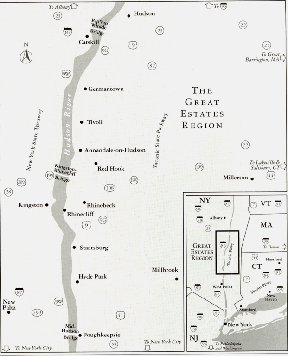 What galvanized Robert was the assumption of his Hudson River
estate. Suddenly the future leapt into focus, and he knew that he wanted to become, as
quickly and painlessly as possible, a country gentleman. The vision transformed this
lackadaisical and indolent creature into a man of vitality and purpose. Ascertaining that
his law practice was paying out too slowly, he abandoned it to become a full – time
merchant. It soon became apparent that he had inherited his father’s eye for a shrewd
investment and his acute sense of timing: a new round of French wars broke out, Robert
launched himself into privateering and within a few short years had become positively
prosperous. What galvanized Robert was the assumption of his Hudson River
estate. Suddenly the future leapt into focus, and he knew that he wanted to become, as
quickly and painlessly as possible, a country gentleman. The vision transformed this
lackadaisical and indolent creature into a man of vitality and purpose. Ascertaining that
his law practice was paying out too slowly, he abandoned it to become a full – time
merchant. It soon became apparent that he had inherited his father’s eye for a shrewd
investment and his acute sense of timing: a new round of French wars broke out, Robert
launched himself into privateering and within a few short years had become positively
prosperous.
Meanwhile, long before he could afford it, he began constructing a fine house on his
upriver estate. The brick mansion, built in the elegant Georgian Style, was sited atop a
fifty – foot bluff commanding a vast sweep of the Hudson – three quarters of a
mile wide at this point – with the mighty peaks of the Catskills forming a dramatic
backdrop. The house became Clarmont the name by which it is known today as a National
Historic Landmark. Robert became know as " Robert of Clermont," an appellation
devised to distinguish this Robert from the five other members of the family who in 1730
shared his name.
For his oldest son, Robert, Philip replicated his own preparation for manor
proprietorship. He firmly believed and adhered to the rule of primogeniture in that his
five younger sons would not share in the manor inheritance, but must be educated to fend
for themselves. Son Robert attended school at New Rochelle just long enough to master the
basics (including business French) and then, in his early twenties, became his
father’s agent in New York. Meanwhile Robert " of Clermont " was bringing
up his only child " to keep an Estate not get one." Robert R. Livingston
commenced the study of law and, unlike his father, showed signs of great promise.
During Philip Livingston’s lifetime, political influence remained a vital
ingredient of financial security in the province of New York so, like his father, Philip
found himself practicing the politics of necessity. As a member of the Governor’s
Council, he exerted a great deal of political power, of which he was as much a slave as
the master. Philip, like his father, found occasional respite from politics by shifting
his focus upriver to the Manor of Livingston, where the economic picture grew brighter
every day. Each year more land was cleared for cultivation more marketable goods were
produced, more quitrents collected and more business done by manor stores and mills. A
large influx of new tenants had been attracted by the size of the leaseholds Philip was
offering – about 170 acres on average, far larger than the corresponding New England
freehold.
All the tenants benefited from the manorial policies of their feudal lord, Philip
Livingston, who expanded the manor’s services and diversified its trading goods.
Philip even concerned himself with the community’s spiritual welfare, building a
church in each new terrant village causing them all to be painted bright red. Paternalism
is not the same as benevolence, and of the latter, Philip Livingston had not a shred.
In 1740, Philip broke ground for his most ambitious project to date, an iron forge near
the eastern boundary of the manor. As the first forge in New York, positioned to
capitalize on the newly opened ore beds in nearby Connecticut, it stood to make an
enormous profit, and Philip’s preoccupation with it verged on obsession. The furnace
took three years to construct.
In the meantime, during the period between 1740 and 1743 the immense Hardenbergh Patent
across the river from the manor had come on the market. Robert of Clermont purchased close
to half a million acres of its prime woodland and choice scenery. His plans for the tract
were a typical combination of the practical and the romantic; they consisted of a grand
Panglasian sweep of hills and valleys, dotted with pretty little model farms on which
happy and prosperous tenants would live in harmony with each other and with their
benevolent lord, himself. In addition to farming their fertile acres, this eager band
would carry out the mining and timbering projects designed to bestow everlasting security
on themselves and vast riches on their master. With this project as lure, and another
round of privateers as security, Robert in 1743 finally turned his back on New York City
and took up full–time residence at Clermont – his dream come true.
Philips’ dream, on the other hand, was faltering badly. His beloved iron forge,
while engrossing more and more of his time, energy and resources, had failed so far to
show a profit. His absorption in it was so great, however, that he too was lured from the
city to establish his base of operations (and his family) on the manor.
Predictably, the brother’s relationship did not benefit from living in close
proximity. Their first squabble arose over water rights to the Roeliff Jansen Kill, the
stream that formed the boundary between their estates. Robert wished to build a gristmill
on the kill, but Philip said that the belonged to him. Consanqrinity, as everyone knows,
tends to turn skirmishes into all out war, and this little spat grew into a legal battle
that persisted over three generations.
By now the proprietor of Livingston Manor had more than one reason to feel testy toward
his younger brother. Robert, having failed to conform to everybody’s dire
predictions, had amassed a comfortable fortune and was supporting himself on Clermont, in
a style to which he had always wished to become accustomed. Adding insult to injury, the
amplitude to his new acreage across the river made Livingston Manor seem positively puny.
Robert’s Hardenbergh land engrossed the whole of Philip’s view: every time he
looked out of his west windows toward the mighty Catskills, everything he saw belonged to
Robert. Finally, Robert, or rather his twenty–four year old only son, Robert R., had
brought off the greatest coup of all: marriage to not just an, but " the " heiress.
She was eighteen-year old Margaret Beekman, daughter of Colonel Henry Beekman, the very
same whose suit to Philip and Robert’s sister, Joanna, had been rejected by their
parents twenty–five years before, and his wife Janet, the daughter of Robert "
the Nephew" Livingston, which meant that the bride and bridegroom were second
cousins, once removed.
Margaret Beekman, as her father’s only surviving child stood to inherit his
portion of the immense Beekman Patent, which lay to the south of Clermont in Dutchess
County. This meant that her children, in turn, Robert of Clermont’s grandchildren,
would eventually go shares in a total of 753,000 acres: Clermont’s 13,000, plus to
500,000 Hardenbergh tract, plus their Beekman mother’s 240,000. It was a mathematical
calculation designed to gall the mind and poison the dreams of Philip, second proprietor
of Livingston Manor.
A French and Indian attack in 1745 on the fort at Saratoga ushered in a new era of
colonial warfare. A raid on Schenectady brought the war very close to the Livingstons at
the manor and Clermont, and the fall of Oswego plunged it right into their pocketbooks.
Philip convinced that Albany would fall and the valley be exposed to the enemy, made plans
to move his family down to New York City, but the Canadians left Albany untouched – perhaps to reciprocate a new policy of neutrality on the part of the Iroquois.
The appointment of James DeLancy, who favored accommodation with the French, as
lieutenant governor of New York, aggravated Philip Livingston’s attack of nerves.
Sitting on the manor, with the military and commercial situation deteriorating around him,
he cannot have been much cheered at the spectacle of his younger brother raking in
proceeds from the war. Robert, together with three of Philip’s own sons, had ventured
once again into privateering and all were realizing huge profits. Although as responsible
citizens they naturally desired the restoration of peace, it is still possible that they
viewed the actual cessation of hostilitions in late 1748 with somewhat mixed emotions.
Phillip’s anxiety about the war, exacerbated by the unmerited good fortune of his
insufferable younger brother, had taken its toll, and no sooner had the peace treaty been
signed than he died at the age of sixty-two, young by Livingston standards.
1749 – 73 Second Generation: Clermont and the Manor
Beginning in 1751 as a minor nuisance, a tenants’ rent strike started on the
eastern end of the manor, near the Massachusetts border. The governor of Massachusetts
officially recognized a group of petitions from Livingston Manor tenants for
Massachusetts’ title to their farms. A boundary dispute had existed for decades
between New York and Massachusetts. The disputed border had been drawn and re-drawn many
times by the contending governments. By 1751 the border claimed by New York was the
Connecticut River and by Massachusetts, a north – south line just twelve miles east
of the Hudson. If the latter should prevail, Livingston Manor would be reduced by half.
Agents of the Massachusetts General Court appeared on the manor and proceeded to lay out
farms on which commonwealth citizens were installed as proprietors. Robert (the
Proprietor) sent men to pull down the houses and eject the interlopers, the New Englanders
returned with reinforcements. Incidents of continued violence increased, and by 1753 a
state of war existed in the eastern manor.
In the spring of 1754 war broke out against the French and Indians in the Ohio valley
and spread quickly eastward to threaten the Hudson. Robert became a principal provisioner
of the colonial troops. An added blessing was that the governments of New York and
Massachusetts facing a common enemy, could no longer afford not to settle their boundary
dispute and began to negotiate the border dispute in earnest. Final settlement took place
in the fall of 1759, at least on paper. The Lords of Trade in London drew a straight north
- south line on the map twenty miles east of the Hudson River and instructed the two
warring colonies to accept it as their mutual border; the line, coinciding precisely with
the eastern border of Livingston Manor.
Robert R. Livingston who had married his cousin, Margaret Beekman, was now in his
mid–forties, a universally esteemed member of New York’s legal and political
fraternity. He currently served in the provincial Assembly with three of his cousins, one
representing the Manor, another the city and county of New York, and a third Dutchess
county. They presented a formidable challenge to the Merchant faction. His legal talents
and reputation were such that he was appointed to the Admiralty Court in 1759 and elevated
four years later to the Supreme Court. In order to distinguish him from all the other
Robert Livingstons, he has always been styled simply " The Judge ".
In April of 1764 the British Parliament in London passed the first of a series of
reform measures designed to clarify and codify the Crown’s relationship with its
American colonies which is, at least, the way the Currency and Sugar Acts were regarded in
London. In America, as we all know, they were viewed quite differently.
Resentment grew warmer still the following year in response to the Stamp and Quartering
Acts. As the date (November 1, 1765) drew near on which the Stamp Act was to take effect,
the Judge and his political allies came together with the popular leadership to organize
the Stamp Act Congress, which met in New York in October. Attended by delegates from nine
of the thirteen colonies, the Congress had no legal standing in the eyes of Great Britain.
Still, its impeccable parliamentary conduct, achieved by the conservative majority and the
elevated style of its address to the King, penned largely by Judge Livingston, lent a
modicum of legitimacy.
Rioting became almost a way of life in New York during the following months, even
years, as each new piece of parliamentary legislation was proclaimed. Nevertheless, ten
years of rioting, of addresses to the King, of burnings in effigy, of parliamentary
bumbling and misunderstanding, had taken their toll.
By 1774 positions in the struggle had hardened on both sides of the Atlantic. As open
conflict with the mother country appeared more and more inevitable, the infighting among
the political parties of New York became less and less relevant.
The Livingstons were not the only Colonial American family with members on opposite
sides of the Revolutionary fence. Even the family’s most celebrated Whigs, Judge
Robert R. Livingston and his son Robert R. Jr., tried to straddle the fence for as long as
possible, and when they did jump, it was with great reluctance and profound misgivings.
But despite their misgivings, despite division within the family ranks, despite
eventual fear for their very lives, the Livingstons who took their stand, stood tall. The
Judge and his cousin Philip labored over the months and years to modulate and legitimize
the course of the resistance. Now approaching their sixth decade of life, they watched,
advised and cheered on the next generation.
1773 – 83 Third Generation: The Reluctant Revolutionary
On the nineteenth of April 1775 British troops engaged fire with Massachusetts
Minutemen at Concord and Lexington, men died on both sides, and the war was on.
The Loyalist interests in the colonial Assembly had managed to block the appointment of
New York delegates to the Second Continental Congress, which was scheduled to convene in
Philadelphia within the month. So the Whigs bypassed the Assembly and invented yet another
extralegal body to serve its purposes. The New York Provisional Convention went into
session on the morning of April 21, selected twelve congressional delegates, and dissolved
itself by afternoon. Three of the twelve chosen to go to Philadelphia were Philip
Livingston, the Manor proprietor’s brother, James Duane, the proprietor’s
son-in-law, and their young cousin on Clermont, Robert R. Livingston, Jr., the
Judge’s son.
All three Livingston delegates entered Congress with extreme ambivalence concerning its
crucial topic, American independence. But if the Manor and Clermont Livingstons were
equally ambivalent at this stage concerning independence, they diverged dramatically in
their expectations for the immediate future. In 1775 both the manor proprietor and the
Judge constructed new mills: the manor’s was for grain, Clermont’s for
gunpowder.
In May of 1776 on his return to Philadelphia, Robert was appointed to the committee to
draft declaration justifying America’s independence in the eyes of the world.
However, his lack of involvement in the actual writing of the Declaration of Independence
was very frustrating. Overshadowed by Jefferson, Adams and Franklin, he contributed not a
single word to the document that was submitted to Congress. Furthermore, on July 2nd,
when Congress finally voted to declare American independence, it did so without the
assenting vote of the delegation from the state of New York, which was forced to abstain.
Congress spent two days debating and amending Jefferson’s text. July 4 is the date on
which it went to the printer. After the New York Convention ratified the Declaration two
weeks later, the vote was retroactively ruled unanimous. Robert was unable to return to
Philadelphia in time to sign the Declaration, which took place on Aug. 2nd. His
cousin Philip was there to give the Livingston seal of approval, and he is known in the
family to this day as " Philip the Signer".
In the fall of 1776, Robert R. Livingston Jr. started and spent much of the ensuing
winter in Fishkill laboring with the committee to draft a state constitution. The New York
State constitution was submitted to the Convention in March of 1777. A predictably
conservative document (penned largely by John Jay, with Robert’s assistance), it won
almost unanimous approval, but was considered far too radical for his cousin, Peter R. of
the manor, whose new fledged ultraconservatism led him to cast the only Nay vote.
Robert was appointed Chancellor of New York, the state’s highest legal office,
second in precedence only to the governorship. The title of Chancellor pleased him
enormously; he employed it to the end of his life, (even after resigning in 1801 to become
minister to France) and is known by is still. On the same day as his appointment his old
friend and now cousin-in-law, John Jay (who was married in 1774 to Sarah Livingston, the
daughter of New Jersey Governor William Livingston) was made chief justice of the state
Supreme Court.
During the War of Independence three of the Manor proprietor’s sons had built
houses on Livingston Manor. In the decades following more than a dozen mansions were built
by members of the family along a twenty mile stretch of the Hudson’s eastern shore,
over half of them by Robert’s sisters and brothers.
Two hundred years ago the Livingstons owned most of the Catskill Mountains. From the
parlor windows of their river mansions they could survey their half million acre alpine
asset across a broad river dotted with hundreds of sails, many of them Livingston sails.
Their descendants gaze through the same windows at the mountains that belong to others and
a river that America has passed by. A lone oil tanker making its silent, ponderous way up
to Albany is an event, something to call the children to the window for. The Hudson
finally looks like what it always was, a dead end.
Dead end or not, " Livingston Valley" is about all the family has to mark its
historical place in the world. The Livingstons’ territorial sense, rooted in time, is
rare nowadays, and modern history has not been benign to such sensibilities. Caught
between past and future, the " Lords of the Manor" frequently stumble and fall
over the present. But always their goal is the same: preservation of the two vital
elements that make them what they are, the Family and the Land.
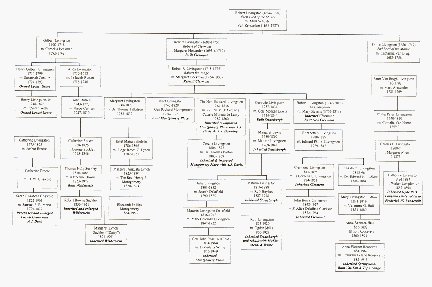
Bibliography
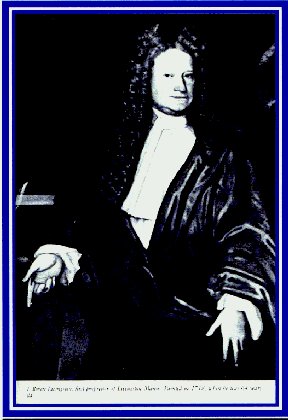
Birmingham, Stephen - America's Secret Aristocracy - Little,
Brown & Co., 1987
Lacey, Rober - Aristocrats - :Little, Brown & Co., 1983
Smith, McKelden - The Great Estates Region of the Hudson River
Valley - Historic Hudson Valley Press, 1998
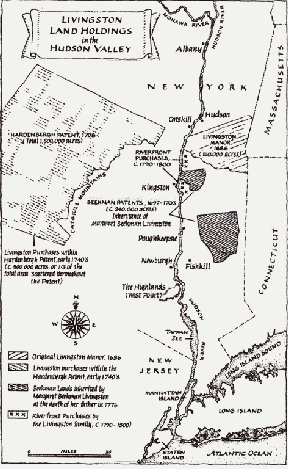
Clermont House and
Livingston Coat of Arms
1997 Shows part
of the 1920's renovation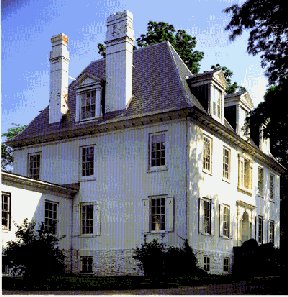
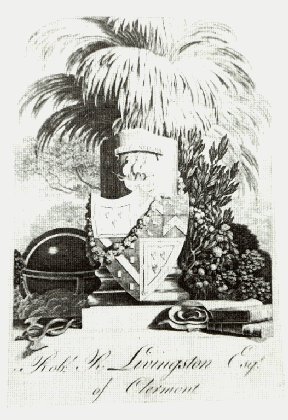
Chancellor
Livingston's Bookplate
Livingston's Scottish Arms
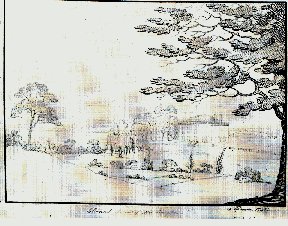
Pen and ink 14 Sept
1796 depicts Clermont
rebuilt after the other house
was burned by the British
in the Revolution.
|